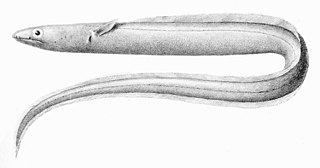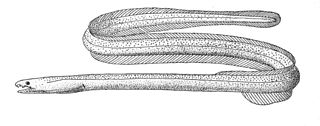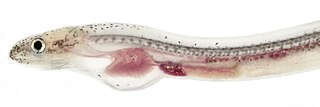
Ophichthidae is a family of fish in the order Anguilliformes, commonly known as the snake eels. The term "Ophichthidae" comes from Greek ophis ("serpent") and ichthys ("fish"). Snake eels are also burrowing eels. They are named for their physical appearance, as they have long, cylindrical, snake-like bodies. This family is found worldwide in tropical to warm temperate waters. They inhabit a wide range of habitats, from coastal shallows and even rivers, to depths below 800 m (2,600 ft). Most species are bottom dwellers, hiding in mud or sand to capture their prey of crustaceans and small fish, but some are pelagic.

Gymnothorax is a genus of fish in the family Muraenidae found in Atlantic, Indian, and Pacific Oceans. With more than 120 species, it the most speciose genus of moray eels.

Uropterygius is a genus of moray eels in the family Muraenidae.

Apterichtus is a genus of fish in the family Ophichthidae. Many of its species are called finless eels.
Bascanichthys is a genus of eels in the snake eel family Ophichthidae. It currently contains the following species:

Brachysomophis is a genus of eels in the snake eel family Ophichthidae.

Echelus is a genus of eels in the snake-eel family Ophichthidae.

Muraenichthys is a genus of eels in the snake eel family Ophichthidae.

Myrophis is a genus of eels in the snake eel family Ophichthidae.
Neenchelys is a genus of snake eels native to the Indian Ocean and the western Pacific Ocean. All species of Neenchelys have two rather than three preopercular pores, a significant character among many species of ophichthids.

Ophichthus is a genus of eels in the snake eel family Ophichthidae.

Scolecenchelys is a genus of eels in the snake eel family Ophichthidae.
Yirrkala is a genus of eels in the snake eel family Ophichthidae. It is named after Yirrkala, an indigenous community in Arnhem Land, in the Northern Territory of Australia.

Myrophinae, the worm eels, is a subfamily of ray-finned fishes belonging to the family Ophichthidae, which also includes the snake eels in the subfamily Ophichthinae.

The rice-paddy eel is an eel in the family Ophichthidae. It was described by Francis Buchanan-Hamilton in 1822, originally in the genus Ophisurus. It is a tropical, marine eel which is known from the Indo-West Pacific, including Somalia, Tanzania, South Africa, India, Pakistan, Sri Lanka, Indonesia, Polynesia, Australia, Bangladesh, Cambodia, Kenya, Madagascar, the Philippines, Malaysia, Mozambique, Seychelles, Saudi Arabia, Taiwan, China, Thailand, Vietnam, and southern Yemen. It is an anadromous species and spawns in freshwater, often in rice paddies during the rainy season, earning it its common name. It also spends time in lagoons, estuaries and coastal rivers, in which it lives in burrows in the river bottom and bank. Males can reach a maximum total length (TL) of 100 centimetres, but more commonly reach a TL of 70 cm.

The longfin snake-eel is an eel in the family Ophichthidae. It was described by John Richardson in 1848. It has a Dorsal fin beginning above its pectoral fin with a snake-like upper body which is cylindrical, but compressed only along its extreme tail tip. It also has a tubular nostril in front and a nostril along lower edge of the lip in back. Colors range from grey to black to brown. Large longfin snake-eels have wrinkled skin.
Pisodonophis hijala is an eel in the family Ophichthidae. It was described by Francis Buchanan-Hamilton in 1822, originally under the genus Ophisurus. It is a marine, tropical eel which is known from the Indo-Pacific.
Pisodonophis hypselopterus is an eel in the family Ophichthidae. It was described by Pieter Bleeker in 1851, originally under the genus Ophisurus. It is a tropical, freshwater and brackish water-dwelling eel which is known from Borneo, Indonesia, and Pohnpei in Asia. Males can reach a maximum total length of 75 centimetres (30 in).

Pisodonophis semicinctus is an eel in the family Ophichthidae. First described by John Richardson in 1848., it is a marine, subtropical eel which is known in the eastern Atlantic Ocean from Gibraltar to Angola. It was first recorded in the Mediterranean Sea in 1958 off Algeria and is now found on both shores of the western Basin. It dwells at a depth range of 10 to 30 m and inhabits the continental shelf, where it forms burrows in sand and mud. Males can reach a maximum total length of 80 cm, but more commonly reach a TL of 60 cm.
Ophichthus retrodorsalis is an eel in the family Ophichthidae. It is found along the Pacific coast of China.














